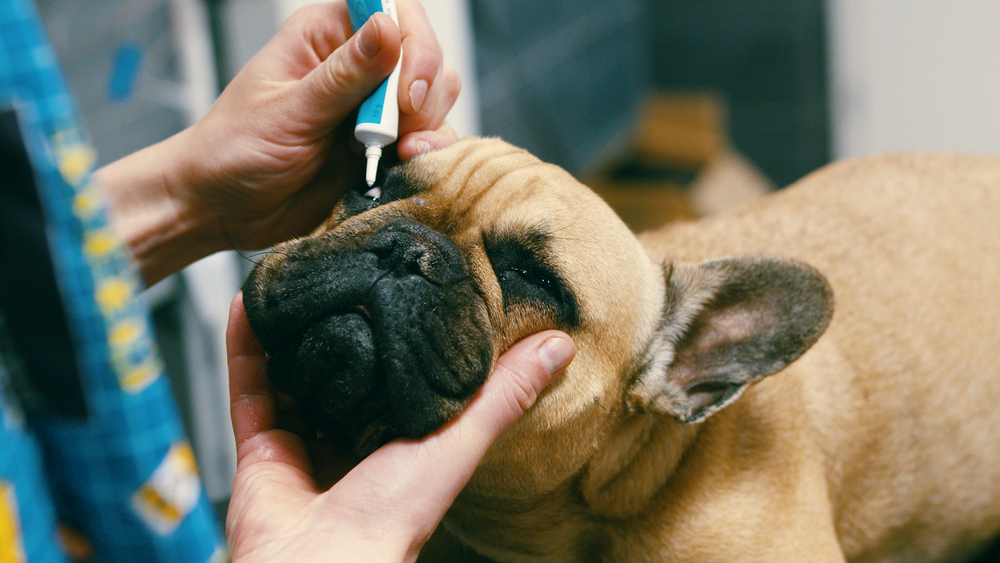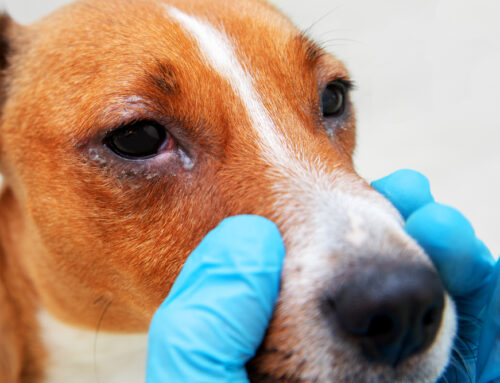Chronic superficial keratitis (i.e., pannus) most commonly affects German shepherds, greyhounds, Belgian malinois, and border collies, but can occur in any dog breed, or mixed breed, at any age. Pannus causes inflammation on the clear eye part (i.e., the cornea) and/or in the third eyelid that arises from the inner eye corner. Pets with severe inflammation from pannus can become vision impaired or blind, but treatment that reduces the inflammation is mostly effective. Veterinary Vision Center’s team are experts at pannus management, and we are providing you with information that will help you recognize the signs and manage this common disease.
What are pannus signs in dogs?
Pannus attacks the cornea (i.e., the clear window that covers the front of the eye) and causes cloudiness, redness from blood vessel ingrowth, and dark-colored pigment in both eyes. The color begins changing at the outside edge, and then moves toward the center. Inflammation causes the changes, which left untreated, can progress and cause blindness. A second form of pannus (i.e., atypical pannus) can occur alone or in combination with classic pannus. Atypical pannus causes inflammatory changes in the third eyelid, which most of the time sits hidden at the inner eye corner and can become reddened and thickened, and normally pigmented tissue can take on a mottled or marbled appearance.
What causes pannus in dogs?
The short answer—we don’t really know. But, we do have a few possibilities. Pannus is considered an autoimmune disease, which occurs when the immune system mistakenly targets and damages normal tissues. Some autoimmune diseases affect multiple body systems, but pannus affects only the eyes. We don’t know why pannus starts, but breed predispositions suggest genetic factors are at play. We also know that UV light can trigger or exacerbate the condition, and dogs who live at higher altitudes with greater UV exposure often have more severe, or difficult to control disease. Some dogs have seasonal flare-ups when they spend more time in the sun.
How is pannus in dogs diagnosed?
Pannus has a characteristic appearance that a veterinary ophthalmologist can diagnose during a routine eye examination. Simple tests, including an eye pressure screening and tear production measurement, can help rule out other conditions and ensure otherwise healthy eyes. Inflammation in pannus occurs only on the eye surface, not inside the eye, so your veterinarian may recommend further testing if they find inflammation that originates from inside the eye.
How is pannus in dogs treated?
Pannus treatment starts aggressively to gain control, prevent progression, and help to reduce or clear corneal inflammation. Pets who respond well to treatment will need fewer or less frequent medications to control their disease. Pannus cannot be cured, but treated pets can go into and remain in remission for long periods. The condition will recur if medications are discontinued, so all pets with pannus need life-long treatment. Medications are usually topical eye drops or ointments, and include an immunomodulator (eg., tacrolimus or cyclosporine) and a steroid (e.g., dexamethasone).
Reducing your pet’s UV light exposure, which may mean spending less time outdoors during peak UV times or going for walks only at dawn or dusk, is another important aspect of pannus treatment. However, many pannus-prone breeds are also intelligent, high energy, or working breeds who need high activity, and restricting outdoor time may not be possible. For these pets, or those living at high altitudes, try UV-protecting goggles, such as the popular Rex Specs and Doggles, which not only protect your pet’s eyes, but also make a fun fashion statement.
What’s the long-term outlook for pannus?

Pannus varies from mild to severe, but usually progresses over time. Pets who are treated early in their disease and take medication as directed tend to have good outcomes. Some pets experience periodic flare-ups, despite medication compliance, while others experience flare-ups only if their medications are stopped. Because pannus is a chronic disease that requires life-long treatment, a veterinary ophthalmologist should monitor your pet’s progress at regularly scheduled intervals—usually at least once or twice per year. Most treated pets maintain good vision throughout their lives, but surgery to remove vision-impairing scarring and pigment in the top corneal layer can be a last resort option. Unfortunately, the scarring and pigment usually recur.
Pannus can threaten your dog’s eye health and vision, but early recognition and proper treatment can help ensure a good outcome. If you suspect your pet may have pannus, or you have noticed any other changes to your dog’s eyes or vision, call and schedule a consultation with the Veterinary Vision Center team.







Leave A Comment